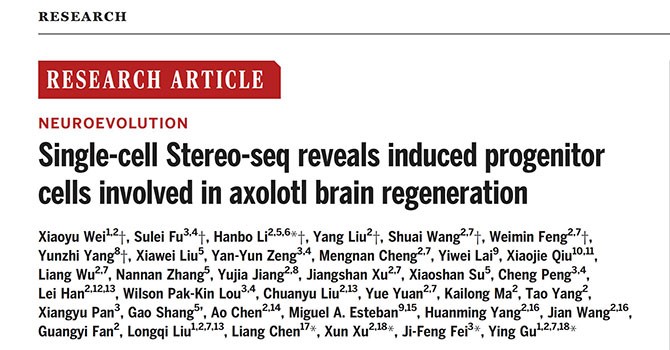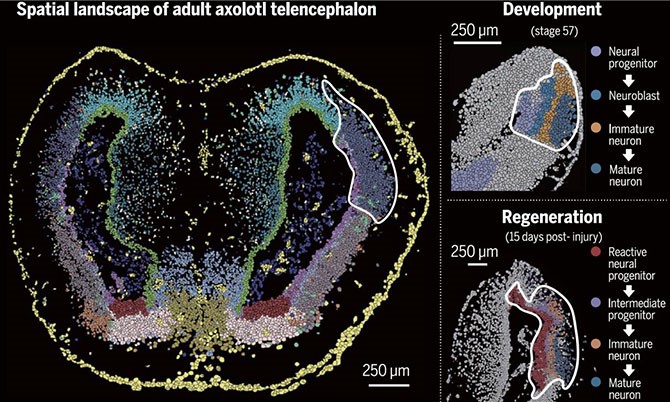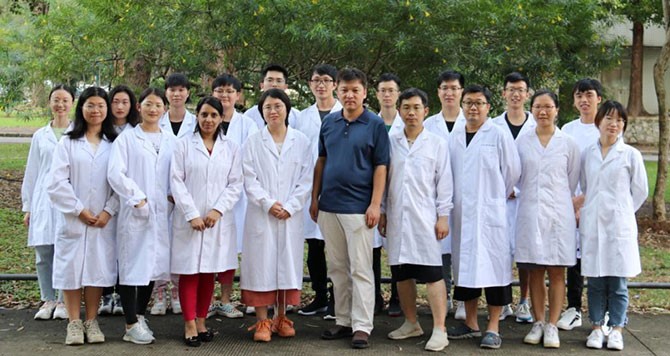

Brain regeneration and repair after an injury is a major biological and medical problem to be solved urgently. Recently, the research team led by Professor Fei Jifeng from the Medical Research Center of our hospital and several other scientific research institutions including BGI Research, have published a research paper entitled Single-cell Stereo-seq Reveals Induced Progenitor Cells Involved in Axolotl Brain Regeneration in Science. They have described the telencephalon regeneration process at the spatiotemporal transcriptome level for the first time and analyzed in detail the cellular and molecular mechanisms involved in Axolotl telencephalon regeneration. This study result provides important guidance to the research on brain regeneration. It is the first time for our hospital to publish a research paper in Science as the institution of the corresponding author.


In this study, the research team constructed an Axolotl telencephalon injury regeneration model, collected a large number of samples on key development and regeneration nodes, used the Spatial Enhanced Resolution Omics Sequencing Technology (Stereo-seq) developed independently by BGI and obtained Stereo-seq data of Axolotl telencephalon development and regeneration at single cell level for the first time in the world. By analyzing the high-resolution Stereo-seq data, the research team drew the atlas of the in situ molecules and cells involved in Axolotl telencephalon development and regeneration and found that the ependymal colloid cells at different parts have different molecular characteristics, suggesting that this may be related to their different functions. More importantly, in this study, the research team found a kind of injury-activated ependymal colloid cell and described in detail its cell lineage changes and molecular characteristics during regeneration. They revealed that it may be the cell source of brain injury regeneration. In addition, the research team also found that the mature neurons near the wound have the ability to reprogram into the state of relatively immature neurons during the regeneration process. They further analyzed their molecular characteristics and possible regulation mechanism. Such a state change may provide favorable environmental conditions for the later effective integration of neural circuits of new neurons. The research team further analyzed the state and spatial distribution of the cell types involved in the brain regeneration and development process and explored the correlation between brain regeneration and brain development based on the cell lineage relationship and dynamic changes of gene expression in the neurogenesis and regeneration process. They found that to a certain extent, brain regeneration is the secondary development of brain. This study not only provides an important reference for the research on brain regeneration of mammals, but also may provide a valuable data resource for studying the brain development, regeneration and evolution of vertebrates.

This study was funded by the Key Special Program for International Cooperation Projects under the National Key Research and Development Program, the National Natural Science Foundation of China, and the Summit Program for the Construction of a High-level Hospital of Guangdong Provincial People's Hospital, etc.
In recent years, Guangdong Provincial People's Hospital has upheld the principle of “invigorating the hospital through talent development", attached great importance to the development of talents at all levels, especially high-end talents, and implemented such high-end talent introduction and development policies as “five 5's" and "five 3's", including giving priority to providing office and test facilities for high-end talents, providing experimental equipment and instruments to meet scientific research needs, allocating recruitment quota to Master and Doctor supervisors for recruiting students and post-doctors, allocating scientific research funds for use in scientific research and team-building freely. These measures have greatly stimulated the enthusiasm and potential of talents. Our hospital has gradually changed the situation of having no scientists who are awarded by the National Science Fund for Distinguished Young Scholars, the National Science Fund for Excellent Young Scholars, and the Provincial Science Fund for Distinguished Young Scholars, and a number of young scientists have also made outstanding achievements. In the future, our hospital will continue to implement the guideline of building a high-level hospital, remain committed to the development concept of “innovation in the system, technology, mode and management", continue to strengthen efforts in talent cultivation, improve the comprehensive service capacity and the quality of medical services to make greater contributions to the “Healthy China Initiative".

Professor Fei Jifeng is instructing the students to do experiments
